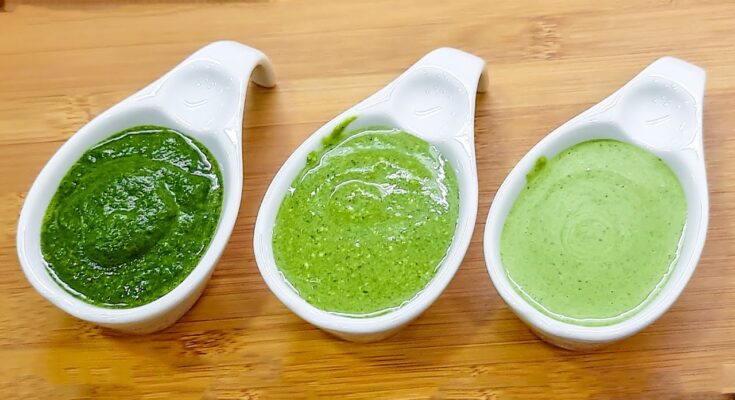Green Chutney Recipe: If there’s one condiment that truly defines the essence of Indian street food and home cooking, it’s Green Chutney. Also known as Hari Chutney, this vibrant green paste is a burst of freshness and flavor, made using fresh herbs and spices. It’s spicy, tangy, sometimes slightly sweet, and always refreshing. You’ve likely tasted it with samosas, chaats, sandwiches, kebabs, or even as a dip with crackers. What’s amazing is how versatile and easy it is to make. Whether you’re an expert cook or just beginning your kitchen adventures, learning to make green chutney is a total game-changer.
Why Green Chutney is a Must-Have
So why should every kitchen have a jar of green chutney? Let’s break it down. First off, it adds a zing to everything it touches. Imagine a plain sandwich turning into something deliciously exciting, all thanks to one generous smear of green chutney. Secondly, it’s packed with nutrition—you’re blending herbs, spices, and lemon juice, all of which are fantastic for your digestive health and overall immunity.
It also fits perfectly into various diets—whether you’re vegetarian, vegan, gluten-free, or on a low-calorie diet, green chutney ticks all the boxes. Plus, making it at home allows you to control the heat, sweetness, and salt levels to your preference. If you haven’t started keeping this little jar of magic in your fridge, trust me, you’re missing out!
Culinary Uses of Green Chutney
Let’s talk about how many ways you can use green chutney, and trust me—it’s more than you think!
- As a Dip: Serve with samosas, pakoras, or fritters.
- As a Spread: Smear it on sandwiches, rolls, or wraps.
- As a Marinade Base: Combine with yogurt or oil to marinate meats or tofu.
- As a Chaat Essential: Pour over sev puri, dahi puri, or bhel puri.
- With Rice: Mix it with steamed rice or serve alongside pulao for an herby touch.
Once you start using it, you’ll find yourself reaching for it more often than ketchup or mustard!
Regional Variations of Green Chutney
Like every great Indian recipe, green chutney has regional twists that make it even more interesting.
- North Indian Style: Typically spicier, with mint, coriander, green chilies, and tangy lemon or amchur.
- Maharashtrian Style: Sometimes includes coconut or roasted peanuts for a nutty flavor.
- Gujarati Version: Slightly sweetened with sugar or jaggery.
- South Indian Twist: May include curry leaves or a tadka (tempering) of mustard seeds and hing.
Each version has its own identity, but they all share that fresh, herbal base that makes green chutney so loved.
List of Ingredients You’ll Need
Let’s gather our ingredients. The beauty of this recipe is its simplicity and flexibility—you can tweak it based on availability and taste preferences.
Fresh Herbs
- Fresh coriander (cilantro) – 1 cup (tightly packed)
- Fresh mint leaves – ½ cup (optional but highly recommended)
Spices and Condiments
- Green chilies – 2 to 3 (adjust to taste)
- Garlic cloves – 2 to 3
- Ginger – ½ inch piece
- Roasted cumin powder – 1 tsp
- Salt – to taste
- Sugar – ½ tsp (optional, balances the flavors)
Liquid Components
- Lemon juice – 1 tbsp (adds tang and preserves color)
- Water – 2 to 3 tbsp (to blend)
Optional Add-ins for Twist
- Yogurt – for creamier texture (esp. in sandwich spread)
- Roasted peanuts or coconut – for a South Indian touch
- Raw mango (kacha aam) – for extra tang (seasonal)
Keep in mind: Freshness is key. Always use fresh herbs and clean, dry leaves to avoid bitterness or quick spoilage.
Step-by-Step Guide to Making Green Chutney
Let’s break this into super easy, follow-along steps that anyone can master.
Step 1: Prepping the Ingredients
Gather fresh cilantro, mint leaves, green chilies, ginger, garlic, lemon juice, and salt. Rinse the herbs thoroughly to remove dirt. Roughly chop everything to make blending easier.
Step 2: Blending the Mixture
Add the cilantro, mint, chilies, ginger, garlic, and a splash of water to a blender. Include lemon juice for brightness. Blend until smooth, scraping the sides as needed. Add only small amounts of water at a time to avoid thinning it too much.
Step 3: Adjusting the Consistency
If the chutney is too thick, add a teaspoon of water or lemon juice. If too thin, add more herbs or a spoonful of yogurt to thicken while keeping the flavor intact.
Step 4: Taste Testing and Tweaking
Taste the chutney and adjust salt, lemon juice, or chilies. Add sugar if you want a slightly sweeter balance.
Step 5: Storing the Chutney
Transfer to an airtight container and refrigerate. It stays fresh for 3–4 days. Enjoy with snacks, sandwiches, or grilled dishes!
Pro Tips for the Perfect Chutney
Want to make your green chutney next-level delicious every single time? These pro tips are what chefs and home cooks swear by:
- Use young coriander stems: Don’t toss the stems away! They pack a punch of flavor and help in blending the chutney smoothly.
- Always use fresh ingredients: Herbs should be vibrant green, not wilted or yellow. The fresher your herbs, the more vibrant your chutney will be.
- Balance the heat: Don’t go overboard with green chilies. Always taste as you go. You can add more spice, but you can’t take it out once it’s in.
- Roast your cumin: Roasting cumin seeds before grinding them gives the chutney a warm, nutty flavor that raw cumin can’t match.
- Use ice-cold water: If you want a bright green chutney, blend using ice cubes or ice water. It helps preserve the color and freshness.
- Avoid over-blending: Over-blending can make the chutney slightly bitter, especially if the blades heat up. Use short pulses.
And here’s a secret weapon: add a slice of green apple or raw mango for natural tartness and a fresh fruity undertone that makes people go, “Wow, what’s in this?!”
Storage Instructions
So you’ve made a big batch of chutney—great move! Now, let’s talk about how to store it the right way so it stays fresh and flavorful for longer.
- Refrigeration: Store your green chutney in a clean, airtight glass jar or container. It will stay fresh for up to 4–5 days in the fridge.
- Avoid plastic containers: Plastic can absorb flavors and smells. Plus, it’s not ideal for storing acidic content like lemon juice.
- Single-use portions: If you’ve made a lot, consider dividing the chutney into smaller jars. This way, you don’t expose the entire batch to air and contamination every time you open it.
- Layer of oil: Pouring a thin layer of neutral oil on top helps preserve it longer and prevents discoloration.
Want to keep it longer than a few days? Read on!
How to Preserve Green Chutney for Weeks
Here’s how to extend the life of your green chutney—without preservatives:
1. Freeze It in Ice Trays
- Pour chutney into an ice cube tray.
- Freeze overnight.
- Pop out the cubes and store them in a zip-lock bag in the freezer.
- Use a cube or two whenever you need—no thawing required if you’re mixing into hot food or marinades.
2. Vacuum Sealing or Airtight Pouches
If you own a vacuum sealer, green chutney is perfect for portion-sealing. It maintains taste and color.
3. Make a Base Chutney
Skip the lemon juice and salt when blending. Just blend herbs, spices, and water. Store this “chutney base” in the freezer. When needed, thaw and add lemon and salt for fresh chutney taste.
Stored well, frozen chutney lasts up to 3 months and retains most of its flavor.
How to Fix Common Mistakes
Sometimes your chutney might not turn out the way you expected. Here’s how to rescue it:
- Too spicy? Add yogurt or a bit of sugar. You can also throw in more mint or coriander to balance it out.
- Too sour? Reduce lemon juice or add a pinch of sugar or a small piece of banana (yes, it works).
- Too watery? Blend in a few peanuts, coconut, or more herbs to thicken it.
- Bitter taste? Likely from over-blending or using old herbs. Fix it with a touch of honey or add a few fresh mint leaves and re-blend.
- Dull green color? Use ice-cold water while blending next time. It also helps to add a little lemon juice right after blending to preserve color.
Remember, cooking is forgiving. A little trial and error is all part of the fun.
Pairing Ideas – What Goes Well With Green Chutney?
Let’s get creative. Green chutney goes way beyond samosas and chaats.
Here are some cool and tasty ideas:
Snacks:
- Pakoras, bhajiyas, aloo tikki
- Hummus platter as an Indian twist
Meals:
- As a side with dal and rice
- Inside grilled cheese or veggie sandwiches
- Mixed into a Buddha bowl dressing
BBQ/Grill:
- Tandoori chicken
- Paneer tikka
- Grilled tofu or mushrooms
Breakfast:
- Dosa, idli, or uttapam
- On toast with avocado
Salads:
- As a herby dressing base with olive oil
With green chutney, the pairing ideas are practically endless. It’s like a flavor passport for your meals.
Nutritional Benefits of Green Chutney
Don’t let the humble appearance fool you—green chutney is a nutritional powerhouse.
Here’s what you’re getting with every spoonful:
| Nutrient | Benefit |
|---|---|
| Coriander & Mint | Rich in antioxidants, vitamin C, aids digestion |
| Ginger & Garlic | Anti-inflammatory, boosts immunity |
| Green Chilies | Rich in Vitamin C, boosts metabolism |
| Lemon Juice | High in Vitamin C, helps iron absorption |
| Cumin | Improves digestion and reduces bloating |
And the best part? It’s low in calories and contains zero preservatives. You’re literally spooning in good health!
Low-Calorie and Vegan Adaptations
If you’re watching your weight or following a vegan lifestyle, green chutney fits in perfectly. It’s naturally:
- Vegan (unless you add yogurt)
- Gluten-free
- Dairy-free
- Low-calorie (10–15 calories per tablespoon!)
Want to make it creamier without dairy? Use:
- Cashews soaked in water
- Vegan yogurt
- Silken tofu for protein-rich texture
Also, skip sugar and use dates for a more natural sweetness. Boom—guilt-free and delicious!
FAQs about Green Chutney Recipe
Q1: How long does green chutney last in the fridge?
A: Typically 3 to 5 days in an airtight container. You can freeze it to extend shelf life.
Q2: Can I make green chutney without mint?
A: Absolutely. Just use coriander, and maybe add a squeeze of lemon or raw mango for extra tang.
Q3: Why does my chutney turn dark quickly?
A: That’s oxidation. Use ice-cold water, fresh herbs, and lemon juice to prevent it.
Q4: Is green chutney good for digestion?
A: Yes! The combination of herbs and spices like mint, ginger, and cumin supports healthy digestion.
Q5: Can I make it in bulk and freeze?
A: 100%. Freeze it in ice cube trays and defrost only what you need. It stays good for up to 3 months.
Conclusion
Green chutney isn’t just a side—it’s a flavor bomb that can transform even the simplest dish into something special. With its vibrant color, bold taste, and impressive health benefits, it’s no wonder this humble condiment has stood the test of time in Indian kitchens.
Whether you’re dipping, spreading, marinating, or just eating it by the spoonful (guilty!), now you have the ultimate guide to making it at home. And once you master this, your meals will never be the same again.
So go on—grab those herbs and fire up your blender. Your next culinary masterpiece is just one chutney away.



